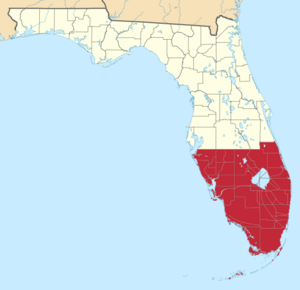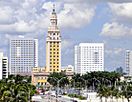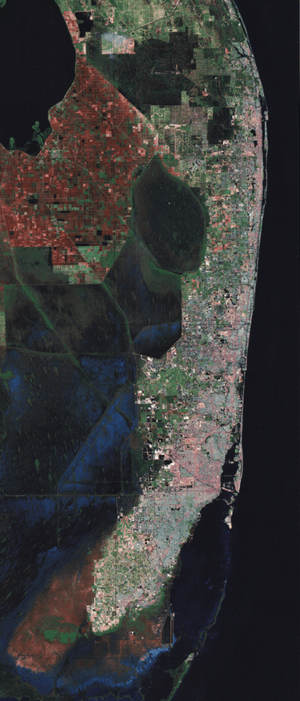South Florida facts for kids
Quick facts for kids
South Florida
|
|
|---|---|
|
Clockwise from top: Downtown Miami seen from Biscayne Bay, South Beach in Miami Beach, Downtown Fort Lauderdale, Mallory Square in Key West, Freedom Tower in Miami, and Anhinga Trail in Everglades National Park
|
|
 |
|
| Country | |
| State | |
| Largest city | |
| Population
(2020)
|
9,484,409 |
South Florida, also called SoFlo, is the southernmost part of the U.S. state of Florida. It is one of Florida's three main regions, along with Central Florida and North Florida. South Florida is the most southern area of the continental United States. It is also the only part of the continental U.S. that has areas with a tropical climate. This means it stays warm all year round.
This region is mostly known for the Miami metropolitan area and the Everglades. It also includes the beautiful Florida Keys. South Florida is home to three U.S. national parks: Biscayne, Dry Tortugas, and Everglades. Many cities are also found here.
Contents
What Makes Up South Florida?
South Florida doesn't have official borders. Different people and groups define it in different ways. A study in 2007 found that most Floridians see "South Florida" as the area from Jupiter, Florida south. This includes the Miami metropolitan area, which is made up of Miami-Dade, Broward, and Palm Beach counties. It also includes the Florida Keys and the inner region called the Glades.
Most often, when people say "South Florida," they mean the "tri-county area" around Miami. Sometimes, people also include Southwest Florida or the Treasure Coast. Southwest Florida is on the state's Gulf Coast. The University of South Florida is in Tampa, which is not considered South Florida.
The state's business agency, Enterprise Florida, calls this area "Southeast Florida." This region includes Monroe County (where the Florida Keys are). It also includes the three big counties of Miami-Dade, Broward, and Palm Beach. Plus, it adds the three "Treasure Coast" counties to the north: Indian River, St. Lucie, and Martin.
People and Population
South Florida is a diverse place with people from all over. Here's a look at where residents were born:
| Population % | Place of Birth |
|---|---|
| 32.2% | State of Florida |
| 33.0% | Elsewhere in the U.S. |
| 34.8% | Outside of the U.S. |
More than 87% of people from other countries living in South Florida come from Latin America.
Major Cities in South Florida
Here are some of the largest cities in South Florida based on how many people live there:
| City | 2020 population | 2010 population | 2000 population | County |
|---|---|---|---|---|
| Miami | 442,241 | 399,457 | 362,470 | Miami-Dade |
| Hialeah | 223,109 | 224,669 | 226,419 | Miami-Dade |
| Fort Lauderdale | 182,760 | 165,521 | 152,397 | Broward |
| Pembroke Pines | 171,178 | 154,750 | 137,427 | Broward |
| Hollywood | 153,067 | 140,768 | 139,368 | Broward |
| Miramar | 134,721 | 122,041 | 72,739 | Broward |
| Coral Springs | 134,394 | 121,096 | 117,549 | Broward |
| Miami Gardens | 111,640 | 107,167 | 124,656 | Miami-Dade |
| West Palm Beach | 117,415 | 99,919 | 82,103 | Palm Beach |
| Pompano Beach | 112,046 | 99,845 | 78,191 | Broward |
| Davie | 105,691 | 91,992 | 75,720 | Broward |
| Miami Beach | 82,890 | 87,779 | 87,933 | Miami-Dade |
| Plantation | 91,750 | 84,955 | 82,934 | Broward |
| Sunrise | 97,335 | 84,439 | 85,787 | Broward |
| Boca Raton | 97,422 | 84,392 | 74,764 | Palm Beach |
| Deerfield Beach | 86,859 | 75,018 | 64,585 | Broward |
| Boynton Beach | 80,380 | 68,217 | 60,389 | Palm Beach |
| Lauderhill | 74,482 | 66,887 | 57,585 | Broward |
| Weston | 68,107 | 65,333 | 49,286 | Broward |
| Delray Beach | 66,846 | 60,522 | 60,020 | Palm Beach |
| Homestead | 80,737 | 60,512 | 31,909 | Miami-Dade |
| Tamarac | 71,897 | 60,427 | 55,588 | Broward |
| North Miami | 60,191 | 58,786 | 59,880 | Miami-Dade |
| Wellington | 61,637 | 56,508 | 38,216 | Palm Beach |
| Jupiter | 61,047 | 55,156 | 39,328 | Palm Beach |
| Margate | 58,712 | 53,284 | 53,909 | Broward |
| Coconut Creek | 57,833 | 52,909 | 43,566 | Broward |
Culture in South Florida
The Miami Accent
The Miami accent is a special way of speaking American English in South Florida. You'll hear it most in Miami-Dade, Broward, Palm Beach, and Monroe counties. This accent started in central Miami and has spread since the 1960s. Young people born in South Florida are most likely to have this accent.
The Miami accent sounds a lot like a standard American accent. But it has some changes similar to accents in the Mid-Atlantic states. This includes areas like New York, Northern New Jersey, and New York Latino English. The Miami accent also has a rhythm and pronunciation that comes from Spanish.
Food and Music
A study found that South Florida is unique because ethnic foods are just as popular as general American cuisine here. Floribbean cuisine is a special type of food that started in South Florida. It mixes flavors from Florida, the Caribbean, Asia, and Latin America.
When it comes to music, there are some differences too. Country music is not as popular in South Florida as it is in North or Central Florida. But Latin music is much more popular here than in other parts of the state.
How Cities Grow
Experts at Florida Atlantic University have noticed how South Florida has grown in an unusual way. Unlike many places with one main city surrounded by development, most of South Florida is natural land or farms. Buildings and cities are mostly found in a narrow, busy strip along the coast. This developed area is very urban and keeps growing, but without one single main city. This pattern is expected to continue.
Ideas for a Separate State
There have been a few ideas to split Florida into two separate states. These ideas are usually more of a political statement than a serious plan. People who suggest this often feel that the state government in Tallahassee (which is in North Florida) doesn't understand the culture, economy, or needs of South Florida.
In 2008, the North Lauderdale City Commission suggested creating a new state of South Florida. This new state would include Palm Beach, Broward, Miami-Dade, and Monroe Counties.
In 2014, the city commission of South Miami also voted for splitting the state in half. Their idea was to include 24 counties in the new State of South Florida. This would roughly include parts of the Tampa Bay and Orlando areas.
See also
 In Spanish: Florida del Sur para niños
In Spanish: Florida del Sur para niños









